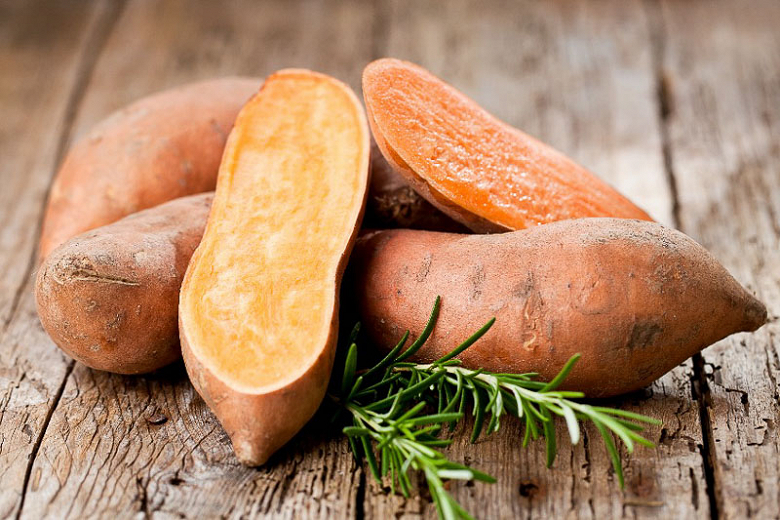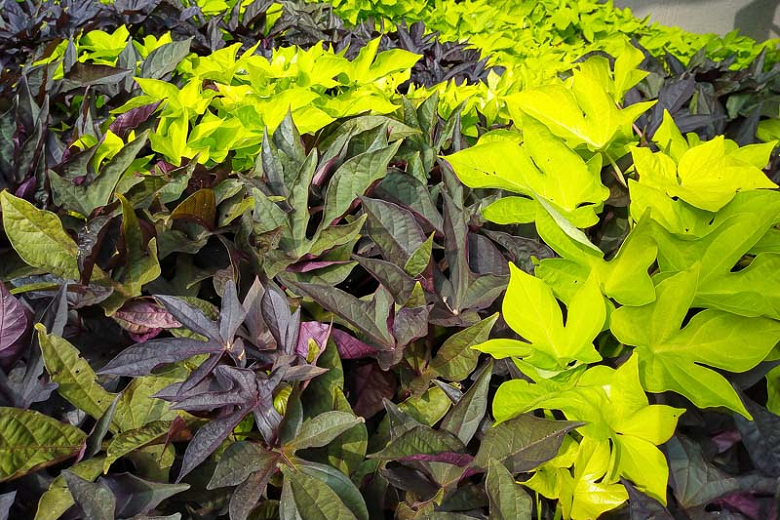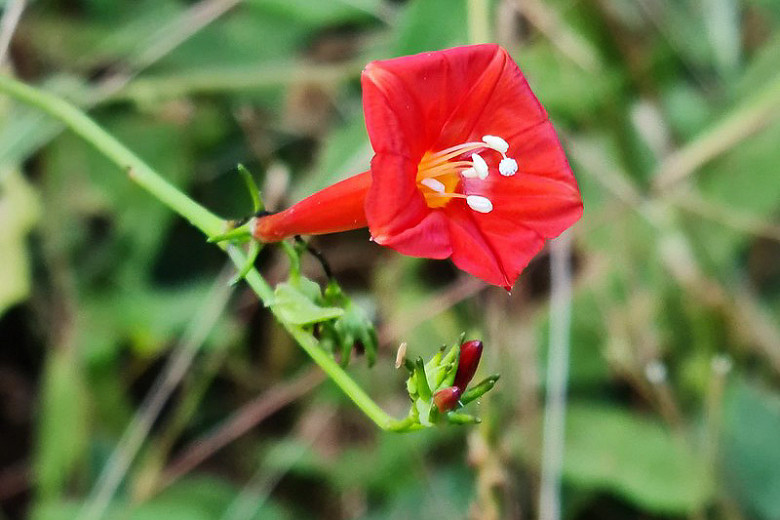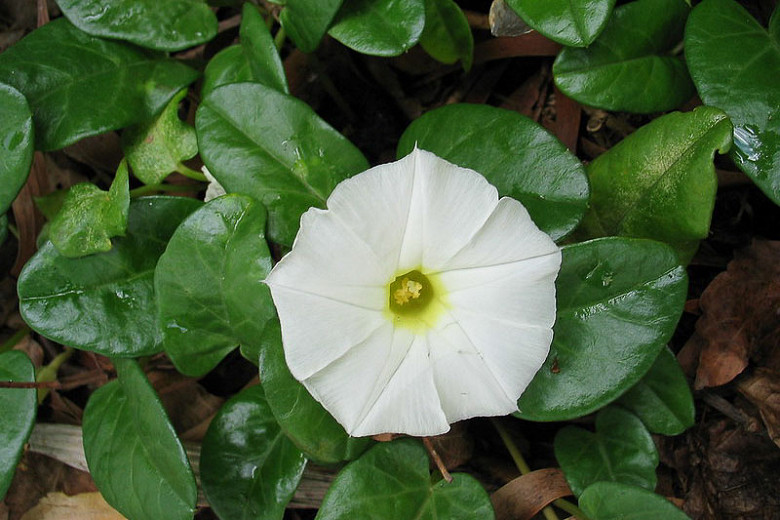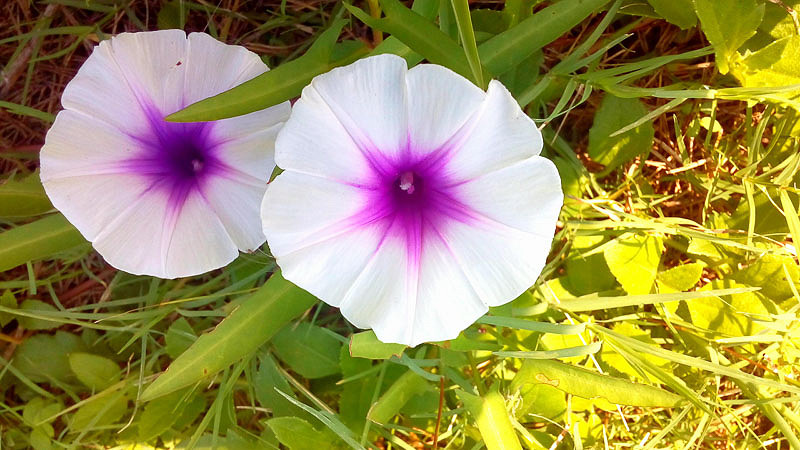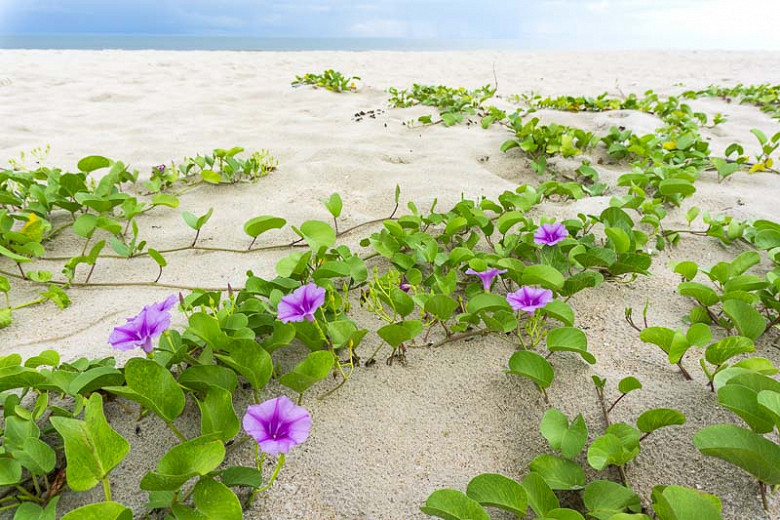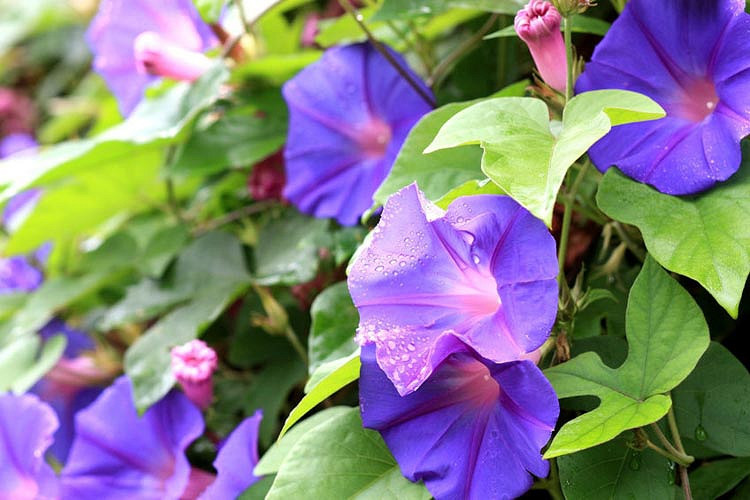Ipomoea batatas (Sweet Potato)
Sweet potato (Ipomoea batatas) is a popular herbaceous perennial vine, grown for its attractive lush foliage (ornamental Sweet potato) or its nutritious, sweet-tasting roots (edible Sweet potato). A beautiful addition to the garden and containers, its edible tubers are ranked as one of the healthiest vegetables because of their high levels of vitamins A, C, iron, potassium, and fiber.
Sweet potato (Ipomoea batatas) is a popular herbaceous perennial vine, grown for its attractive lush foliage (ornamental Sweet potato) or its nutritious, sweet-tasting roots (edible Sweet potato). A beautiful addition to the garden and containers, its edible tubers are ranked as one of the healthiest vegetables because of their high levels of vitamins A, C, iron, potassium, and fiber.
What are Sweet Potatoes?
- Sweet potatoes belong to the morning glory family, Convolvulaceae.
- Despite their common name, Sweet potatoes are not even botanically related to regular potatoes, which are stem tubers in the nightshade family.
- Sweet potatoes are native to tropical Central and South America and have been cultivated for at least 5,000 years.
- Today, Sweet potatoes are cultivated in tropical and warm temperate climates worldwide. They are an essential food crop in the tropical Americas, the Caribbean, the warm Pacific islands, the East Indies, India, China, and Japan.
- Sweet potatoes are twining perennial climbers, often grown as annuals, with some cultivars valued for their edible and delicious roots.
- Leaves are usually ovate to heart-shaped and come in bright green, dark purple, chartreuse, and variegated colors. Funnel-shaped flowers, often purple (sometimes white), are produced in summer.
- Edible Sweet potatoes are the same species as the sweet potato vining plants commonly grown in gardens and containers as ornamentals.
- Tubers of the ornamental varieties are edible but are not as tasty as those of the varieties bred explicitly for food production.
- Sweet potatoes are slow-growing and require warm temperatures to develop their cylindrical tubers, which are up to 12 inches long (30 cm), and weigh up to about one pound.
- Sweet potato plants come back every year if you live in a warmer growing zone (USDA zones 9 through 11).
- There are hundreds of varieties of Sweet potatoes. Some have white or cream-colored flesh. Others are yellow, red, or purple.
- In some parts of North America, Sweet potatoes are called yams. However, this is a misnomer since yams belong to a different species.
- Popular Sweet potato cultivars include Beauregard, Centennial, Jewel, and Vardaman.
Health Benefits of Sweet Potatoes
- While Sweet potatoes make a colorful and flavorful addition to various dishes, they also provide health benefits.
- Sweet potatoes are low in calories but are rich in vitamins and minerals.
- Vitamin A: one serving (100 g) provides 380% of your daily needs. This vitamin is essential for your eyes, immune system, heart, and kidneys.
- Vitamin C: one serving (100 g) provides 33% of your daily needs. Vitamin C strengthens the immune system.
- Potassium: one serving (100 g) provides 14% of your daily needs. Potassium is important for blood pressure control and may help reduce your risk of heart disease.
- Sweet potatoes also contain a good amount of iron, potassium, and fiber.
- Carotenoids might lower your risk for cancer.
- Sweet potatoes can decrease your LDL or bad cholesterol and reduce the risks of heart disease.
- Note: Sweet potatoes are high in carbohydrates. When baked, roasted, or fried, their glycemic index can be increased, causing your blood sugar to spike. Talk to your doctor or a dietitian if you have type 2 diabetes.
- Nutrition Facts (per 100 grams): 90 calories, 21 grams carbs, 2 grams protein, 0 grams fat, 3 grams fiber.
Cooking with Sweet Potatoes
- Sweet potatoes have a sugary-sweet flavor with earthy undertones and hints of nuttiness.
- Sweet potatoes are versatile and can be baked, roasted, steamed, boiled, simmered, or fried.
- They can be served as a whole or mashed – just like regular potatoes.
- Sweet potatoes can be thinly sliced and sautéed for use in casseroles, ratatouille, or lasagna, cubed and simmered in soup, chili, or coconut curries, cut into wedges, and fried.
- Sweet potatoes are famous for an American Thanksgiving side dish, mashed Sweet potatoes, and marshmallow casserole.
- Sweet potatoes may be used as a pie filling, pairing well with spices like nutmeg, cinnamon, and allspice and the sweet flavors of maple syrup or brown sugar.
- The foliage is edible and very nutritious. Eat it fresh in a green salad or sauté with other vegetables.
- Sweet potatoes should not be refrigerated but rather stored loose in a cool, dry place away from direct sunlight.
Growing Sweet Potatoes
- Sweet potatoes grow up to 6-12 in. tall (15-30 cm) and 8-10 ft. wide (240-300 cm), depending on the variety.
- Sweet potatoes perform best in fertile, slightly acidic (pH ranging from 5.5 to 6.5), loose, sandy loam, or very sandy, well-drained soil in full sun (at least 6-8 hours of direct sunlight per day).
- Consider using raised beds if your soil is clay, rocky, or compacted.
- To prepare the ground, add plenty of organic matter, such as garden compost.
- Depending on the variety, Sweet potatoes take 85-120 days to harvest after planting the slips.
- Sweet potatoes love warm weather and are extremely heat tolerant. They grow best between 65-95°F (18-35°C). They can tolerate frosts if the soil temperature stays above 55°F (13°C).
- Sweet potatoes are tuberous plants that are not grown from seed. They are grown through slips or small potato vines that will sprout from Sweet potato tubers.
- Plant slips outdoors 3-4 weeks after your last spring frost or once the soil has warmed to at least 65°F (18°C). Nighttime temperatures should be at least 55°F (13°C).
- Planting in ridges allows the soil to warm faster in the spring, improves drainage, and gives the roots room to expand. Ridging also makes harvesting easier.
- The ridges should be 6 to 8 inches tall (15-20 cm) and about 12 inches wide (30 cm).
- Plant slips about 12 to 18 inches apart (30-45 cm) with 3 to 4 feet between rows so that there is enough room for your Sweet potato vines to grow.
- Water with a high-phosphorus liquid fertilizer, then water thoroughly for 7 to 10 days to give the plants a good start.
- Keep the soil evenly moist but not soggy until the vines begin to spread.
- Sweet potato is sensitive to drought for the first 50 to 60 days after planting. Water deeply and regularly during dry periods. But excessive water can cause root rots and storage roots to split.
- Use row covers to protect your sweet potatoes from late frosts or cool nights.
- Side-dress the sweet potato plants 3 to 4 weeks after transplanting with 5-10-10 fertilizer.
- Avoid top-dressing after early summer, or root formation may be interrupted.
- Weed carefully until the plant begins to grow. The rapidly growing vines will shade out weeds, so little additional weeding is needed.
- Mulch to retain moisture, keep the soil warm, and control weeds.
- After harvest, cut vines and let them dry, then compost or till under to reduce disease buildup.
- Rotate crops: Prevent problems by not planting Sweet potatoes in the same field two years in a row.
- Sweet potatoes are susceptible to a few pests. Keep an eye out for aphids, flea beetles, slugs, snails, whiteflies, and red spider mites when grown under glass.
- Sweet potatoes are susceptible to diseases, including fusarium wilt, powdery mildew, Sweet potato scurf, and white rust.
Harvesting and Storing Sweet Potatoes
- Dig potatoes carefully before the first frost, after the foliage starts to yellow.
- Use a garden fork or spade to loosen the soil and gently lift and expose the Sweet potatoes.
- Handle them with care, gently removing attached soil clumps. Don't rub the skin or wash roots before storing them indoors.
- If the vines are exposed to frost, dig the roots immediately (to avoid decay in dead vines passing down to the roots).
- If immediate digging is impossible, cut away vines and add loose soil over the rows to protect the Sweet potatoes from the cold.
- Curing causes the conversion of starch to sugar, giving your potatoes a sweet taste. It also helps to heal skin cuts that could lead to rot.
- Cure healthy potatoes for ten days in an 80-85°F humid area (26-30°C). Spreading the roots in a single layer is best – so they are not touching.
- Gradually reduce temperature and store them through the winter, lined with newspaper for good air movement, in a 55-60°F humid room (13-15°C).
- After curing, Sweet potatoes can be stored in a cool, dry place for several months.
Best Companion Plants for Sweet Potatoes
- Aromatic herbs such as dill, thyme, and oregano work well with Sweet potatoes.
- Alyssum makes a perfect living mulch for them while attracting beneficial insects like wasps.
- Borage flowers are pretty and not only attract beneficial insects but can deter pests from your Sweet potatoes. As a bonus, they are edible.
- Bush beans: the growth of many creepers, such as Sweet potatoes, proves helpful in controlling weeds. This benefits the companion plants by allowing them to get their required nutrients without the competition of hardy weeds.
- Some pole bean varieties can be trained to grow along the ground intermingled with Sweet potato vines.
- Catnip attracts beneficial insects and helps to repel flea beetles, a common pest found on many vegetable crops, including Sweet potatoes.
- Daisies attract tachinid flies, which will prey on the larvae of moths, beetles, sawflies, stink bugs, and other insects.
- Garlic keeps some pests away, such as aphids, Japanese beetles, mites, cabbage looper, ants, cabbage maggots, fruit borers, red spider mites, and slugs.
- Marigolds help to repel nematodes that destroy root systems, whiteflies, aphids, and other pests.
- Mustard can be planted as a trap crop to deter flea beetles from your Sweet potato plants.
- Nasturtium flowers are among the most popular companion plants because they repel various pests, including aphids and beetles. As an added bonus, the pretty flowers are edible.
- Radish serves as a trap crop for flea beetles.
- Root crops such as beets and parsnips work well with Sweet potatoes.
- Lemon balm attracts parasitic wasps and hoverflies and can help manage all the worms affecting Sweet potatoes.
- Summer savory helps to confuse and repel the Sweet potato weevil. It is good to attract honey bees too.
-
Yarrow attracts predatory wasps, ladybugs, lacewings, and spiders to your sweet potato garden, keeping the pests under control.
Worst Companion Plants for Sweet Potatoes
Requirements
| Hardiness | 9 – 11 |
|---|---|
| Climate Zones | 8, 9, 10, 12, 13, 14, 15, 18, 19, 20, 21, 22, 23, 24, H1, H2 |
| Plant Type | Climbers, Perennials |
| Plant Family | Ipomoea – Morning Glories |
| Exposure | Full Sun |
| Season of Interest | Summer (Mid,Late)Fall |
| Height | 6" – 1' (15cm – 30cm) |
| Spread | 8' – 10' (240cm – 3m) |
| Water Needs | Average |
| Maintenance | Low |
| Soil Type | Loam, Sand |
| Soil pH | Acid, Neutral |
| Soil Drainage | Moist but Well-Drained, Well-Drained |
| Characteristics | Showy |
| Tolerance | Deer, Drought, Dry Soil |
| Attracts | Bees |
| Garden Uses | Beds and Borders, Patio and Containers, Wall-Side Borders |
